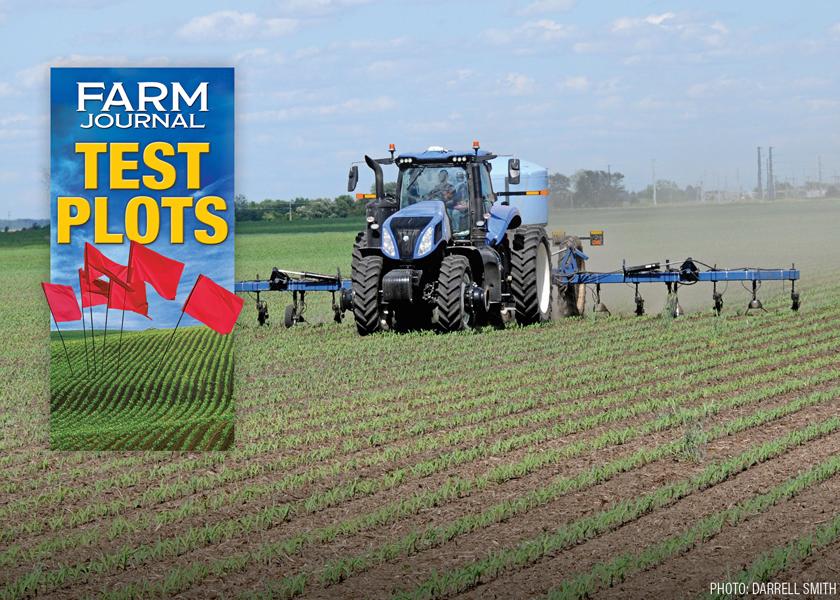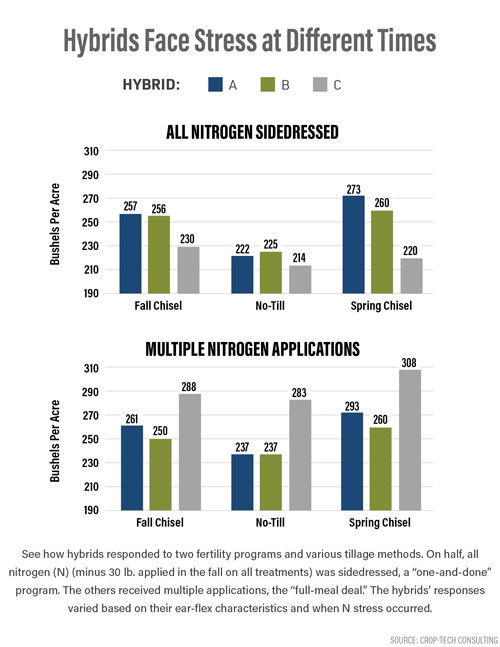Corn Management: Meet Your Hybrids’ Needs

Some require nitrogen early, some require it late
Of the many factors that impact yield, two stand out above the others, says Farm Journal Field Agronomist Ken Ferrie.
“The biggest factor is water management,” he says. “The second is hybrid management.”
Managing a hybrid means protecting it from stress, which impacts yield no matter when it occurs during the growing season. That’s why Ferrie says, “Never let corn have a bad day.” Preventing bad days requires taking advantage of a hybrid’s strengths and farming around its weaknesses.
HYBRID MANAGEMENT
The Farm Journal Test Plot program has been studying the value of managing hybrids, based on plant characteristics, for several years. Here are the 2021 plot details:
Hybrids: Based on their ear-flex characteristics gained from previous studies, Ferrie chose three hybrids to test.
Field conditions: The plot was in second-year continuous corn, which increases the chances of stress from the carbon penalty, allelopathy and disease.
Tillage: One-third of the treatments were fall chiseled, one-third were spring chiseled and one- third were no-tilled. “This created three scenarios for carbon penalty and allelopathic stresses,” Ferrie says. “Fall chiseling allowed more time for decomposition, reducing the carbon penalty. Spring chiseling, which rolled the residue into the soil just before planting, created the highest carbon penalty. No-till had the least carbon penalty, because it had the slowest residue breakdown, but it resulted in cooler soils at planting.”
Fertility management: The study compared two nitrogen (N) programs. The entire field received 30 lb. of N per acre in the fall, broad-cast in dry fertilizer that also included phosphorus, potassium and sulfur. Half the treatments received the remainder of their N, 220 lb. per acre, as a sidedress application on June 8 (the “one-and-done” program).
The other treatments received multiple applications of N (the “full-meal deal”). At planting, 10 lb. of N per acre (as 10-34-0 plus zinc) was applied in the furrow and about ¾" on each side, in addition to 60 lb. per acre 2" below the surface and 2" beside the row. Another 60 lb. per acre of N was broadcast before emergence, and 90 lb. per acre was sidedressed on June 8. In total, it was 250 lb. of N per acre.
“The 10-34-0 starter added cost to the full-meal deal, but it was critical for some hybrids,” Ferrie says.
Hybrid A did not gain enough additional yield to pay the cost of starter on fall-chiseled ground; in fact, its ROI was $29 per acre less than the one-and-done treatment. It broke even with one-and-done on spring-chiseled ground and gained $59 per acre on no-till.
“Because this hybrid flexes in length and mostly after tasseling, it can handle stressful conditions early and late in the season,” Ferrie says. “With Hybrid A, you want to avoid stress from the rapid growth stage through R4.”
Hybrid B responded to the full-meal deal over the other program, to the tune of $290 per acre in fall-chiseled soil, $344 in no-till and $442 in spring chiseling.
“This hybrid flexes in girth, but mostly in kernel depth,” Ferrie says. “It will flex in girth if stressed early and in depth if stressed later. It can handle stress during rapid growth, but it needs a strong start and finish.”
Hybrid C responded to the full-meal deal by returning $20 per acre more on fall-chiseled ground, $76 per acre more on no-till and $102 per acre more on spring-chiseled ground. The return was highest where the carbon penalty was greatest.
“Hybrid C can’t stand stress from the rapid growth stage to R4,” Ferrie says. “It has to get off to a strong start, but it can handle stress at the end of the season since it does not flex in kernel depth.”

RESPOND TO THE ENVIRONMENT
“Understanding a hybrid’s characteristics will tell you how it will respond to different environments, such as droughty soil, and man-agement styles, such as your preferred fertilizer program, Ferrie says: “It makes management easier, and you respond to the environ-ment, rather than letting the growing season just happen to you.”
Darrell Smith works with Ken Ferrie to share the systems approach to farming.







